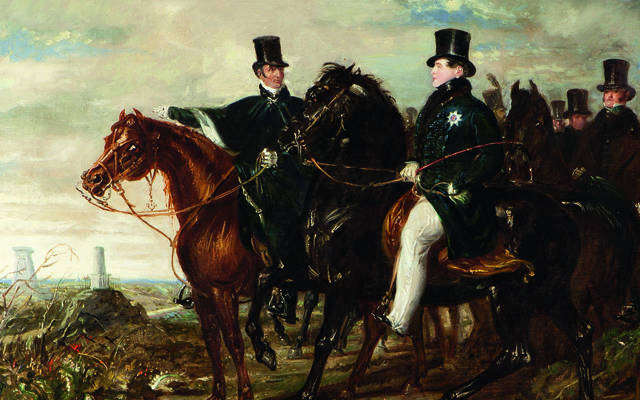Exhibition review: ‘Wellington: Triumphs, Politics and Passions’ in London
Susan Jenkins sees a show that casts new light on Wellington.


This year marks the anniversaries of two celebrated British military victories against the French: the 600th anniversary of the Battle of Agincourt and the bicentenary of the Battle of Waterloo. The National Portrait Gallery is commemorating the latter with its first exhibition devoted to Arthur Wellesley, 1st Duke of Wellington (1769–1852), entitled ‘Wellington: Triumphs, Politics and Passions’.
Associate Curator Paul Cox seeks to present the Iron Duke as more than just a military leader so that visitors will ‘gain a fuller picture of Wellington as a man, rather than simply as a hero’. The exhibition includes significant and rarely seen loans from private collections, including the Duke’s London home, Apsley House (No 1, London) and his country seat, Stratfield Saye, Hampshire.
‘Triumphs, Politics and Passions’ explores Wellington’s military, political and personal activities through a fascinating selection of 59 works of art. Some are well known, particularly portraits of the Duke painted after his military successes. These include Francisco de Goya’s famous Peninsular War portrait, begun in 1812, and Sir Thomas Lawrence’s iconic portrait of about 1815, familiar from the back of an old £5 note.
The exhibition also delightfully captures the obscure lives of rank-and-file soldiers, described by their commander as ‘the scum of the earth’. Lt Edmund Wheatley’s charmingly illustrated diary, made for his sweetheart Eliza Brookes, records his service in Wellington’s campaigns from 1812 to about 1815. Captured by Napoleon’s troops at Waterloo, Wheatley subsequently returned home to marry Eliza, who could then admire his diary sketches, including the ‘accurate likeness of [the] drunken face’ of Lt Henry Llewellyn of the 5th battalion King’s German Legion.
Wellington’s political career was considerably less glorious than his military one. Serving twice as Prime Minister—from 1828 to 1830 and again briefly in 1834—he was satirised in contemporary prints for his unpopular policies. His support in 1829 for the Catholic Relief Bill, for instance, led to prints such as Doing Homage (William Heath, 1829), depicting the Duke kneeling to kiss the Pope’s foot.
Lawrence’s unfinished portrait of Wellington, commissioned in 1829 by leading Tory political hostess Sarah, Countess of Jersey, shows a pensive leader during his premiership. This reflective portrait has never previously been on public display in the UK and is on loan from a private collection.
Wellington’s personal life was also beset with problems. Despite the delicate beauty of Lawrence’s drawing of Catherine (Kitty), Duchess of Wellington (1814), the Duke remarked just before his renewed marriage proposal, ‘she has grown ugly, by Jove’. Several popular prints of his extramarital liaisons appeared on the market, including The Flat Catcher, and the Rat Catcher (Isaac Robert Cruikshank, 1825), which publicised his affair with the notorious London courtesan Harriette Wilson.
Sign up for the Country Life Newsletter
Exquisite houses, the beauty of Nature, and how to get the most from your life, straight to your inbox.
The National Portrait Gallery’s exhibition explores Wellington as both military hero and flawed individual. It begins with 18th-century artist John Hoppner’s portrait of the young Arthur Wellesley (or Wesley, as he spelt it then) of about 1795 and ends with Antoine Claudet’s daguer-reotype of Wellington taken on his 75th birthday in 1844.
Mr Cox hopes that the show, which reflects the Duke’s openness to technological change, will ‘bring Wellington to life for a modern audience unlike anything else’.
‘Wellington: Triumphs, Politics and Passions’ is at the National Portrait Gallery, London WC2, until June 7 (020–7306 0055; www.npg.org.uk)
Country Life is unlike any other magazine: the only glossy weekly on the newsstand and the only magazine that has been guest-edited by HRH The King not once, but twice. It is a celebration of modern rural life and all its diverse joys and pleasures — that was first published in Queen Victoria's Diamond Jubilee year. Our eclectic mixture of witty and informative content — from the most up-to-date property news and commentary and a coveted glimpse inside some of the UK's best houses and gardens, to gardening, the arts and interior design, written by experts in their field — still cannot be found in print or online, anywhere else.
-
 Vertigo at Victoria Falls, a sunset surrounded by lions and swimming in the Nile: A journey from Cape Town to Cairo
Vertigo at Victoria Falls, a sunset surrounded by lions and swimming in the Nile: A journey from Cape Town to CairoWhy do we travel and who inspires us to do so? Chris Wallace went in search of answers on his own epic journey the length of Africa.
By Christopher Wallace
-
 A gorgeous Scottish cottage with contemporary interiors on the bonny banks of the River Tay
A gorgeous Scottish cottage with contemporary interiors on the bonny banks of the River TayCarnliath on the edge of Strathtay is a delightful family home set in sensational scenery.
By James Fisher